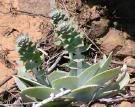

Scientific Name
Dichanthelium clandestinum
Uses of Deertongue: Landscaping, Medicinal, Culinary, etc...
The major use of deertongue is for revegetating disturbed areas where site conditions limit the use of other species. It is tolerant of sites with: (1) a pH as low as 3.8, (2) aluminum concentration which limits growth of other species, and (3) light textured soil which is droughty and infertile. These tolerances allow deertongue to excel when revegetating acid coal and other surface mine spoils, and sandy infertile disturbed areas.
General Characteristics
Deertongue is a perennial, warm season grass native to the Eastern United States and Southeastern Canada. The midsummer growth normally reaches a height of one to three feet. The leaf sheath and stem are hairy. Leaves are one-half to one and one-quarter inches wide and four to eight inches long. In autumn culms form a very leafy rosette, four to six inches in height. Deertongue produces short, strong rhizomes. Two seed crops are produced annually: an early crop on an open terminal panicle and a later crop in a panicle enclosed in the swollen leaf sheath. The second crop, produced in the enclosed panicle, produces an abundance of seed. Deertongue has about 400,000 seeds per pound. Deertongue lodges over winter and forms a mat of vegetative cover. Some of the stems break off and are carried away by wind or water. Much of the seed is retained in the leaf sheaths of the old stems.
Required Growing Conditions
The natural distribution is Nova Scotia, Quebec, and Maine to Kansas, south to northern Florida and Texas. Deertongue is widely scattered throughout this area volunteering onto denuded sites. It grows well on non-cultivated soil. Because of its tolerance to low pH, high concentrations of aluminum, and droughty infertile conditions, it is commonly found to volunteer on such sites.
Cultivation and Care
The type of sites where deertongue is recommended and its seed dormancy characteristics influence the method and timing of establishment. Deertongue should be seeded as early as possible in the spring. Seed dormancy is easily overcome when deertongue is planted during cool weather, so that natural stratification in the soil will occur. If the site conditions restrict early spring planting, it is advisable to sow seed in the late fall or early winter, while dormant.On sites where conventional farm equipment can operate, prepare seedbed as normal for a pasture planting. Use a grain or grass drill; do not place seed deeper than one inch. In sand and gravel pits, the method of choice is to broadcast, then 'track' the seed with lime and fertilizer in with a bulldozer. Hydroseed steep or rough areas, but expect this method to result in less success than those outlined above. Expect slow establishment of seedings.Mulching is beneficial for seedling establishment and erosion control, except in sand and gravel pits. Two tons of straw or hay tacked down is the most desirable method. Where this is not possible, wood fiber mulch should be used at 1,500 pounds per acre.Deertongue is most often planted in mixtures with other warm season grasses such as switchgrass with the total rate of 12-15 pounds per acre. Typically, deertongue does not exceed 3 pounds of the per-acre mix.
General Upkeep and Control
In lieu of a soil test, two tons of lime and 300 to 400 pounds of 10-10-10 fertilizer per acre are suggested for deertongue plantings on critical areas. Where conditions permit, these materials should be worked into the soil surface during site preparation. Additional fertilizer applications may be needed after a stand has emerged in order to develop a vigorous plant cover. Once good cover has developed, plant vigor will be maintained without additional fertilizer treatments. It can be mowed (1-2 times per year) if necessary to improve appearance.
Cultivars, Improved, and Selected Materials (and area of origin) ‘Tioga’ (northeast US) is the only variety of deertongue. It was developed by the Big Flats Plant Materials Center and released for commercial production in 1975. Seed is available from commercial sources.





0 comments: